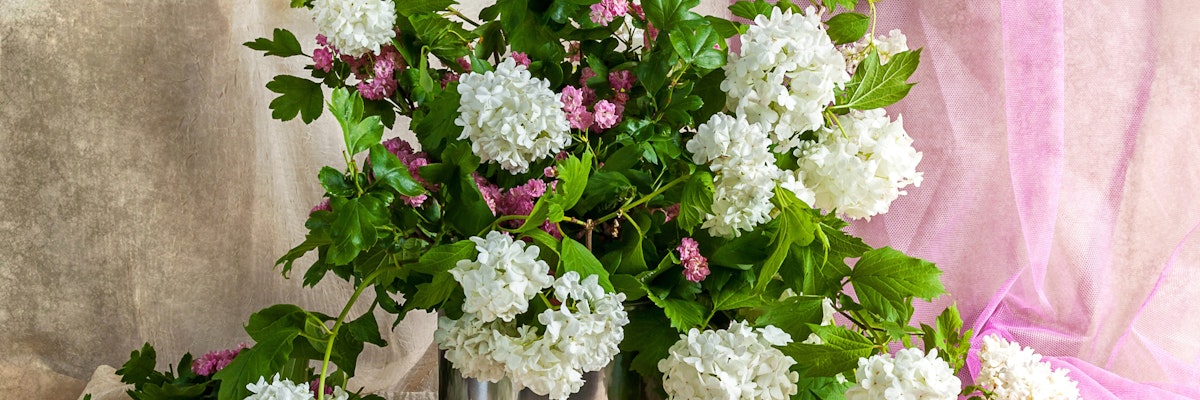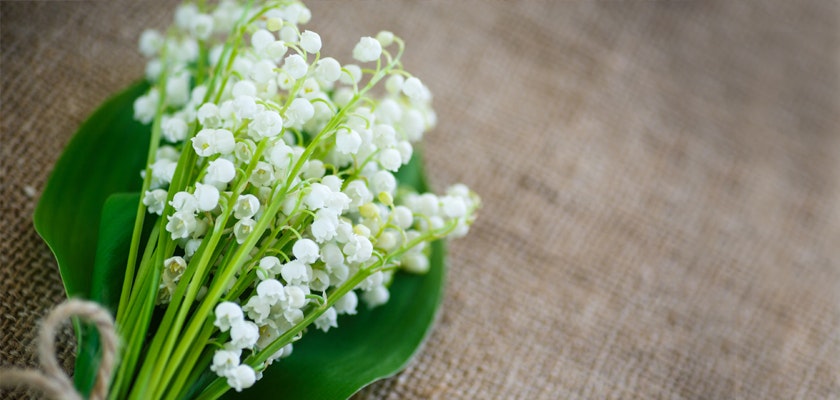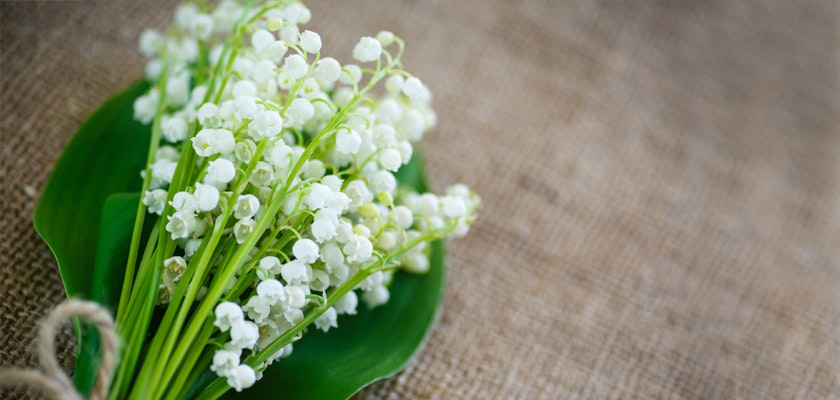Discover May Birth Flowers: The Lily of the Valley and Hawthorn
May is a month that epitomizes renewal and natural beauty, with flowers blooming in abundance and nature springing back to life.
Explore May's birth flowers, lily of the valley and hawthorn, with BloomsyBox
Among the many blossoms that May brings, two flowers stand out for their charm and symbolism: the lily of the valley and hawthorn. These flowers, traditionally associated with the month of May, have captivated hearts and minds for centuries, each carrying unique meanings and historical significance.
Explore May's birth flowers, lily of the valley and hawthorn, with BloomsyBox
Among the many blossoms that May brings, two flowers stand out for their charm and symbolism: the lily of the valley and hawthorn. These flowers, traditionally associated with the month of May, have captivated hearts and minds for centuries, each carrying unique meanings and historical significance.
Lily of the valley (Convallaria majalis) is a perennial plant known for its delicate, fragrant bell-shaped white flowers. Native to the cool temperate regions of the Northern Hemisphere, it thrives in shaded areas, spreading through rhizomes to create lush carpets of greenery and blossoms. The sweet scent and ethereal appearance of lily of the valley make it a popular choice for bridal bouquets and springtime floral arrangements.
Hawthorn (Crataegus), on the other hand, is a robust deciduous shrub or small tree belonging to the rose family. It boasts clusters of small, fragrant white or pink flowers and thorny branches. Native to temperate regions of Europe, Asia, and North America, hawthorn has been revered for its medicinal properties and symbolic meanings throughout various cultures.
The symbolism of these May birth flowers is deeply rooted in history and folklore. Lily of the valley traditionally represents purity, humility, and a return to happiness. Its association with love and devotion has made it a favorite in romantic contexts. Hawthorn, often called the "May Tree," symbolizes protection, hope, and the promise of new beginnings. It also carries connotations of love and marriage, making it a fitting companion to lily of the valley.
Both flowers have rich historical narratives. Lily of the valley has connections to ancient Greek mythology and Christian symbolism, while hawthorn features prominently in Celtic lore and medieval traditions. Their stories add depth to their beauty and make them more than just ornamental plants; they are carriers of cultural heritage and human emotions.
Whether you are celebrating a May birthday, planning a wedding, or simply looking to enhance your garden, the lily of the valley and hawthorn offer timeless elegance and meaning. Their adaptability and resilience make them suitable for various landscaping needs, while their historical and cultural associations add a layer of significance to their presence.
Embracing the essence of these May birth flowers can bring a touch of grace and history into your home. From their care requirements to their fascinating backstories, the lily of the valley and hawthorn are more than just flowers—they are symbols of life's enduring cycles and the beauty of renewal.
What is the History of the Lily of the Valley?
The lily of the valley has a storied history that dates back to ancient civilizations. In Greek mythology, it is linked to the tale of Apollo and the nymph Smilax. According to legend, Smilax transformed into a delicate white flower, now believed to be lily of the valley, to escape Apollo's advances. This story imbues the flower with themes of love and unattainable beauty.
In Christian tradition, lily of the valley is often referred to as "Our Lady's Tears" or "Mary's Tears." According to folklore, the flower sprang from the Virgin Mary's tears during the crucifixion of Jesus Christ. This connection to Mary imbues the flower with a sense of purity, sorrow, and spiritual rebirth. In medieval Europe, lily of the valley was closely associated with May Day celebrations, symbolizing the return of spring and the renewal of life.
The flower also holds special significance in Scandinavian folklore. It was believed to bring good luck and protect against evil spirits when carried on one's person. As a symbol of innocence and purity, lily of the valley was often used in bridal bouquets and wreaths, representing the bride's fresh start and the couple's hopeful future.
During the Victorian era, the language of flowers—or floriography—gave lily of the valley additional layers of meaning. It became a symbol of a return to happiness and was used to convey messages of love and devotion. Victorian lovers would exchange small bouquets of lily of the valley to express their feelings subtly yet profoundly.
Today, lily of the valley continues to be cherished for its historical and cultural significance. Its delicate beauty and enchanting fragrance make it a popular choice for weddings, anniversaries, and other celebrations of love and renewal. Whether used in gardens or floral arrangements, lily of the valley remains a timeless symbol of grace and purity.
How to Care for Lily of the Valley
1. Sunlight: Lily of the valley thrives in partial to full shade. Choose a planting location that receives dappled sunlight or is shaded for most of the day. Too much direct sunlight can scorch the delicate leaves and flowers.
2. Planting: Plant lily of the valley rhizomes in early spring or late summer/early fall. Dig a hole slightly larger than the rhizome, place it in the soil with roots spread out evenly, cover with soil, and water thoroughly to help the plant settle.
3. Soil: Lily of the valley prefers well-drained, fertile soil rich in organic matter. Amend the soil with compost or well-rotted manure to improve its texture and nutrient content, ensuring optimal growth conditions.
4. Watering: Keep the soil consistently moist but not waterlogged. Water deeply whenever the top inch of soil feels dry. During hot summer months, increase watering frequency to prevent the soil from drying out completely.
5. Mulching: Apply a layer of organic mulch around the plants to retain moisture, regulate soil temperature, and suppress weeds. Mulching also helps protect the rhizomes from extreme cold in winter.
6. Fertilization: Fertilize lily of the valley in early spring with a balanced, slow-release fertilizer. Avoid over-fertilizing, as excessive nutrients can lead to lush foliage at the expense of flowers.
7. Division: Lily of the valley tends to spread rapidly. Every 2-3 years, divide overcrowded clumps in early spring or late summer to rejuvenate the plants and prevent overcrowding, promoting healthier growth.
8. Pest Control: Monitor for pests such as slugs and snails, which can damage the leaves. Use organic pest control methods like diatomaceous earth or copper tape to keep these pests at bay without harming the plants.
9. Disease Management: Lily of the valley is generally disease-resistant, but ensure good air circulation and avoid overhead watering to prevent fungal issues. Remove any infected leaves promptly to maintain plant health.
10. Winter Care: In regions with cold winters, apply a layer of mulch over the soil to protect the rhizomes from freezing temperatures. Remove the mulch in early spring once the threat of frost has passed to encourage new growth.
3 Interesting Facts About Lily of the Valley
1. Toxicity: Despite its delicate appearance and sweet fragrance, all parts of the lily of the valley are highly toxic if ingested. This toxicity extends to pets and humans alike, making it crucial to handle the plant with care, especially in households with children or animals. The plant contains cardiac glycosides, which can cause serious health issues if consumed.
2. Fragrance: The scent of lily of the valley is often described as a blend of floral, sweet, and slightly green notes, reminiscent of fresh-cut grass and morning dew. This captivating aroma has inspired many perfumers and continues to be a beloved scent in various products, including perfumes, candles, and toiletries. The fragrance is thought to evoke feelings of nostalgia and tranquility.
3. Cultural Significance: In France, lily of the valley is customarily given on May 1, a public holiday known as La Fête du Muguet (May Day). This tradition dates back to the early 20th century and symbolizes good luck and happiness. People give small bouquets of the flowers to friends and loved ones as a gesture of affection and well-wishing. The practice remains a cherished part of French culture, reflecting the flower's enduring popularity and positive connotations.
Lily of the valley (Convallaria majalis) is a perennial plant known for its delicate, fragrant bell-shaped white flowers. Native to the cool temperate regions of the Northern Hemisphere, it thrives in shaded areas, spreading through rhizomes to create lush carpets of greenery and blossoms. The sweet scent and ethereal appearance of lily of the valley make it a popular choice for bridal bouquets and springtime floral arrangements.
Hawthorn (Crataegus), on the other hand, is a robust deciduous shrub or small tree belonging to the rose family. It boasts clusters of small, fragrant white or pink flowers and thorny branches. Native to temperate regions of Europe, Asia, and North America, hawthorn has been revered for its medicinal properties and symbolic meanings throughout various cultures.
The symbolism of these May birth flowers is deeply rooted in history and folklore. Lily of the valley traditionally represents purity, humility, and a return to happiness. Its association with love and devotion has made it a favorite in romantic contexts. Hawthorn, often called the "May Tree," symbolizes protection, hope, and the promise of new beginnings. It also carries connotations of love and marriage, making it a fitting companion to lily of the valley.
Both flowers have rich historical narratives. Lily of the valley has connections to ancient Greek mythology and Christian symbolism, while hawthorn features prominently in Celtic lore and medieval traditions. Their stories add depth to their beauty and make them more than just ornamental plants; they are carriers of cultural heritage and human emotions.
Whether you are celebrating a May birthday, planning a wedding, or simply looking to enhance your garden, the lily of the valley and hawthorn offer timeless elegance and meaning. Their adaptability and resilience make them suitable for various landscaping needs, while their historical and cultural associations add a layer of significance to their presence.
Embracing the essence of these May birth flowers can bring a touch of grace and history into your home. From their care requirements to their fascinating backstories, the lily of the valley and hawthorn are more than just flowers—they are symbols of life's enduring cycles and the beauty of renewal.
What is the History of the Lily of the Valley?
The lily of the valley has a storied history that dates back to ancient civilizations. In Greek mythology, it is linked to the tale of Apollo and the nymph Smilax. According to legend, Smilax transformed into a delicate white flower, now believed to be lily of the valley, to escape Apollo's advances. This story imbues the flower with themes of love and unattainable beauty.
In Christian tradition, lily of the valley is often referred to as "Our Lady's Tears" or "Mary's Tears." According to folklore, the flower sprang from the Virgin Mary's tears during the crucifixion of Jesus Christ. This connection to Mary imbues the flower with a sense of purity, sorrow, and spiritual rebirth. In medieval Europe, lily of the valley was closely associated with May Day celebrations, symbolizing the return of spring and the renewal of life.
The flower also holds special significance in Scandinavian folklore. It was believed to bring good luck and protect against evil spirits when carried on one's person. As a symbol of innocence and purity, lily of the valley was often used in bridal bouquets and wreaths, representing the bride's fresh start and the couple's hopeful future.
During the Victorian era, the language of flowers—or floriography—gave lily of the valley additional layers of meaning. It became a symbol of a return to happiness and was used to convey messages of love and devotion. Victorian lovers would exchange small bouquets of lily of the valley to express their feelings subtly yet profoundly.
Today, lily of the valley continues to be cherished for its historical and cultural significance. Its delicate beauty and enchanting fragrance make it a popular choice for weddings, anniversaries, and other celebrations of love and renewal. Whether used in gardens or floral arrangements, lily of the valley remains a timeless symbol of grace and purity.
How to Care for Lily of the Valley
1. Sunlight: Lily of the valley thrives in partial to full shade. Choose a planting location that receives dappled sunlight or is shaded for most of the day. Too much direct sunlight can scorch the delicate leaves and flowers.
2. Planting: Plant lily of the valley rhizomes in early spring or late summer/early fall. Dig a hole slightly larger than the rhizome, place it in the soil with roots spread out evenly, cover with soil, and water thoroughly to help the plant settle.
3. Soil: Lily of the valley prefers well-drained, fertile soil rich in organic matter. Amend the soil with compost or well-rotted manure to improve its texture and nutrient content, ensuring optimal growth conditions.
4. Watering: Keep the soil consistently moist but not waterlogged. Water deeply whenever the top inch of soil feels dry. During hot summer months, increase watering frequency to prevent the soil from drying out completely.
5. Mulching: Apply a layer of organic mulch around the plants to retain moisture, regulate soil temperature, and suppress weeds. Mulching also helps protect the rhizomes from extreme cold in winter.
6. Fertilization: Fertilize lily of the valley in early spring with a balanced, slow-release fertilizer. Avoid over-fertilizing, as excessive nutrients can lead to lush foliage at the expense of flowers.
7. Division: Lily of the valley tends to spread rapidly. Every 2-3 years, divide overcrowded clumps in early spring or late summer to rejuvenate the plants and prevent overcrowding, promoting healthier growth.
8. Pest Control: Monitor for pests such as slugs and snails, which can damage the leaves. Use organic pest control methods like diatomaceous earth or copper tape to keep these pests at bay without harming the plants.
9. Disease Management: Lily of the valley is generally disease-resistant, but ensure good air circulation and avoid overhead watering to prevent fungal issues. Remove any infected leaves promptly to maintain plant health.
10. Winter Care: In regions with cold winters, apply a layer of mulch over the soil to protect the rhizomes from freezing temperatures. Remove the mulch in early spring once the threat of frost has passed to encourage new growth.
3 Interesting Facts About Lily of the Valley
1. Toxicity: Despite its delicate appearance and sweet fragrance, all parts of the lily of the valley are highly toxic if ingested. This toxicity extends to pets and humans alike, making it crucial to handle the plant with care, especially in households with children or animals. The plant contains cardiac glycosides, which can cause serious health issues if consumed.
2. Fragrance: The scent of lily of the valley is often described as a blend of floral, sweet, and slightly green notes, reminiscent of fresh-cut grass and morning dew. This captivating aroma has inspired many perfumers and continues to be a beloved scent in various products, including perfumes, candles, and toiletries. The fragrance is thought to evoke feelings of nostalgia and tranquility.
3. Cultural Significance: In France, lily of the valley is customarily given on May 1, a public holiday known as La Fête du Muguet (May Day). This tradition dates back to the early 20th century and symbolizes good luck and happiness. People give small bouquets of the flowers to friends and loved ones as a gesture of affection and well-wishing. The practice remains a cherished part of French culture, reflecting the flower's enduring popularity and positive connotations.
What is the History of the Hawthorn?
Hawthorn has a long and rich history steeped in myths, legends, and folklore. In Celtic mythology, the hawthorn was considered a sacred tree with protective qualities. It was often planted near homes and villages to shield inhabitants from harm and ward off evil spirits. The Celts believed that the hawthorn served as a gateway between the mortal world and the Otherworld, where gods and spirits resided.
In Christian tradition, the hawthorn gained significance due to its association with Jesus Christ. Some legends suggest that the crown of thorns worn by Jesus during his crucifixion was made from hawthorn branches. This connection imbued the tree with a sense of holiness and sacrifice. Additionally, hawthorn was often used to decorate maypoles and garlands during May Day celebrations, symbolizing the arrival of spring and the renewal of life.
Medieval Europe saw the hawthorn becoming an emblem of chastity and purity. It was believed that placing a hawthorn branch under one's pillow could prevent nightmares and promote restful sleep. The tree's fragrant blossoms were used in bridal wreaths and bouquets, representing hope and new beginnings for newlyweds. Hawthorn was also utilized in various medicinal concoctions, believed to cure ailments ranging from digestive issues to heart conditions.
Hawthorn's protective qualities extended into folklore, where it was said to offer protection against lightning strikes and malevolent spirits. In rural communities, it was common to see hawthorn hedges surrounding farmland to safeguard crops and livestock. This practice not only provided practical benefits but also reinforced the tree's symbolic role as a guardian and protector.
Today, hawthorn continues to be valued for its medicinal properties and ornamental beauty. Modern herbal medicine recognizes hawthorn for its potential cardiovascular benefits, including improving heart health and blood circulation. Its hardy nature and ability to thrive in diverse environments have also made it a popular choice for landscaping and hedgerows.
How to Care for the Hawthorn
1. Sunlight: Hawthorns prefer full sun to partial shade, requiring at least six hours of direct sunlight per day. Adequate sunlight ensures healthy growth and promotes abundant flowering.
2. Soil Preparation: While hawthorns can tolerate various soil types, they thrive best in well-drained loamy or sandy soils. Before planting, amend the soil with organic matter such as compost to improve drainage and nutrient content.
3. Planting: Plant hawthorn trees in early spring or late fall when the weather is cool. Dig a hole slightly wider and deeper than the root ball, place the tree in the hole, and backfill with soil. Ensure the top of the root ball is level with the surrounding soil.
4. Watering: Newly planted hawthorn trees require regular watering to establish deep roots. Water thoroughly after planting and continue to water regularly during the first growing season. Once established, hawthorns are relatively drought-tolerant but benefit from occasional deep watering during dry periods.
5. Mulching: Apply a layer of organic mulch around the base of the tree to retain moisture, regulate soil temperature, and suppress weeds. Mulching also helps protect the shallow root system from temperature extremes and reduces competition for nutrients.
6. Pruning: Prune hawthorn trees during the dormant season, typically in late winter or early spring, before new growth begins. Remove dead, diseased, or crossing branches to maintain the tree's shape and encourage healthy growth. Avoid heavy pruning during the growing season to prevent stress.
7. Fertilization: In most cases, hawthorns do not require fertilization if planted in nutrient-rich soil. However, if the soil is poor, applying a balanced slow-release fertilizer in early spring can support growth and flowering.
8. Pest Control: Monitor hawthorn trees for common pests such as aphids, caterpillars, and lace bugs. Use organic pest control methods or insecticidal soap to manage infestations. Regularly inspect the tree to catch pest issues early.
9. Disease Management: Hawthorns are susceptible to fungal diseases such as leaf spot and powdery mildew. Ensure good air circulation by spacing trees adequately and avoiding overhead watering. Remove and dispose of infected leaves promptly to reduce the spread of disease.
10. Winter Care: Protect young hawthorn trees from frost and freezing temperatures by wrapping the trunk with tree wrap or burlap. This practice helps prevent frost cracks and damage to the bark. Mature trees are generally more resilient but may still benefit from mulch to insulate the roots.
What is the History of the Hawthorn?
Hawthorn has a long and rich history steeped in myths, legends, and folklore. In Celtic mythology, the hawthorn was considered a sacred tree with protective qualities. It was often planted near homes and villages to shield inhabitants from harm and ward off evil spirits. The Celts believed that the hawthorn served as a gateway between the mortal world and the Otherworld, where gods and spirits resided.
In Christian tradition, the hawthorn gained significance due to its association with Jesus Christ. Some legends suggest that the crown of thorns worn by Jesus during his crucifixion was made from hawthorn branches. This connection imbued the tree with a sense of holiness and sacrifice. Additionally, hawthorn was often used to decorate maypoles and garlands during May Day celebrations, symbolizing the arrival of spring and the renewal of life.
Medieval Europe saw the hawthorn becoming an emblem of chastity and purity. It was believed that placing a hawthorn branch under one's pillow could prevent nightmares and promote restful sleep. The tree's fragrant blossoms were used in bridal wreaths and bouquets, representing hope and new beginnings for newlyweds. Hawthorn was also utilized in various medicinal concoctions, believed to cure ailments ranging from digestive issues to heart conditions.
Hawthorn's protective qualities extended into folklore, where it was said to offer protection against lightning strikes and malevolent spirits. In rural communities, it was common to see hawthorn hedges surrounding farmland to safeguard crops and livestock. This practice not only provided practical benefits but also reinforced the tree's symbolic role as a guardian and protector.
Today, hawthorn continues to be valued for its medicinal properties and ornamental beauty. Modern herbal medicine recognizes hawthorn for its potential cardiovascular benefits, including improving heart health and blood circulation. Its hardy nature and ability to thrive in diverse environments have also made it a popular choice for landscaping and hedgerows.
How to Care for the Hawthorn
1. Sunlight: Hawthorns prefer full sun to partial shade, requiring at least six hours of direct sunlight per day. Adequate sunlight ensures healthy growth and promotes abundant flowering.
2. Soil Preparation: While hawthorns can tolerate various soil types, they thrive best in well-drained loamy or sandy soils. Before planting, amend the soil with organic matter such as compost to improve drainage and nutrient content.
3. Planting: Plant hawthorn trees in early spring or late fall when the weather is cool. Dig a hole slightly wider and deeper than the root ball, place the tree in the hole, and backfill with soil. Ensure the top of the root ball is level with the surrounding soil.
4. Watering: Newly planted hawthorn trees require regular watering to establish deep roots. Water thoroughly after planting and continue to water regularly during the first growing season. Once established, hawthorns are relatively drought-tolerant but benefit from occasional deep watering during dry periods.
5. Mulching: Apply a layer of organic mulch around the base of the tree to retain moisture, regulate soil temperature, and suppress weeds. Mulching also helps protect the shallow root system from temperature extremes and reduces competition for nutrients.
6. Pruning: Prune hawthorn trees during the dormant season, typically in late winter or early spring, before new growth begins. Remove dead, diseased, or crossing branches to maintain the tree's shape and encourage healthy growth. Avoid heavy pruning during the growing season to prevent stress.
7. Fertilization: In most cases, hawthorns do not require fertilization if planted in nutrient-rich soil. However, if the soil is poor, applying a balanced slow-release fertilizer in early spring can support growth and flowering.
8. Pest Control: Monitor hawthorn trees for common pests such as aphids, caterpillars, and lace bugs. Use organic pest control methods or insecticidal soap to manage infestations. Regularly inspect the tree to catch pest issues early.
9. Disease Management: Hawthorns are susceptible to fungal diseases such as leaf spot and powdery mildew. Ensure good air circulation by spacing trees adequately and avoiding overhead watering. Remove and dispose of infected leaves promptly to reduce the spread of disease.
10. Winter Care: Protect young hawthorn trees from frost and freezing temperatures by wrapping the trunk with tree wrap or burlap. This practice helps prevent frost cracks and damage to the bark. Mature trees are generally more resilient but may still benefit from mulch to insulate the roots.
3 Interesting Facts About the Hawthorn
1. Edible Berries: The berries of certain hawthorn species, known as haws, are edible and used in various culinary applications. They have a tart flavor and can be made into jams, jellies, and syrups. Traditional recipes often incorporate haws for their unique taste and nutritional benefits. Hawthorn berries are also used in herbal teas and tinctures, valued for their potential health benefits, particularly in supporting cardiovascular health and digestion.
2. Medicinal Uses: Hawthorn has a long history of use in traditional medicine. The berries, leaves, and flowers contain compounds that support heart health, including antioxidants and bioflavonoids. These components are believed to strengthen the heart muscle, improve blood flow, and reduce blood pressure. Modern herbalists use hawthorn extracts to treat conditions such as heart disease, high blood pressure, and digestive disorders. Scientific studies have validated some of these traditional uses, highlighting hawthorn's potential as a natural remedy for cardiovascular issues.
3. Longevity: Hawthorn trees are known for their longevity and resilience, with some specimens living for several centuries. Their ability to thrive in diverse environments and withstand challenging conditions makes them symbols of endurance and strength. In landscapes, hawthorns provide year-round interest, with beautiful blooms in spring, attractive foliage in summer, vibrant berries in autumn, and a structural presence in winter. Their long-lived nature and historical significance add a sense of continuity and heritage to gardens and natural spaces.
3 Interesting Facts About the Hawthorn
1. Edible Berries: The berries of certain hawthorn species, known as haws, are edible and used in various culinary applications. They have a tart flavor and can be made into jams, jellies, and syrups. Traditional recipes often incorporate haws for their unique taste and nutritional benefits. Hawthorn berries are also used in herbal teas and tinctures, valued for their potential health benefits, particularly in supporting cardiovascular health and digestion.
2. Medicinal Uses: Hawthorn has a long history of use in traditional medicine. The berries, leaves, and flowers contain compounds that support heart health, including antioxidants and bioflavonoids. These components are believed to strengthen the heart muscle, improve blood flow, and reduce blood pressure. Modern herbalists use hawthorn extracts to treat conditions such as heart disease, high blood pressure, and digestive disorders. Scientific studies have validated some of these traditional uses, highlighting hawthorn's potential as a natural remedy for cardiovascular issues.
3. Longevity: Hawthorn trees are known for their longevity and resilience, with some specimens living for several centuries. Their ability to thrive in diverse environments and withstand challenging conditions makes them symbols of endurance and strength. In landscapes, hawthorns provide year-round interest, with beautiful blooms in spring, attractive foliage in summer, vibrant berries in autumn, and a structural presence in winter. Their long-lived nature and historical significance add a sense of continuity and heritage to gardens and natural spaces.




